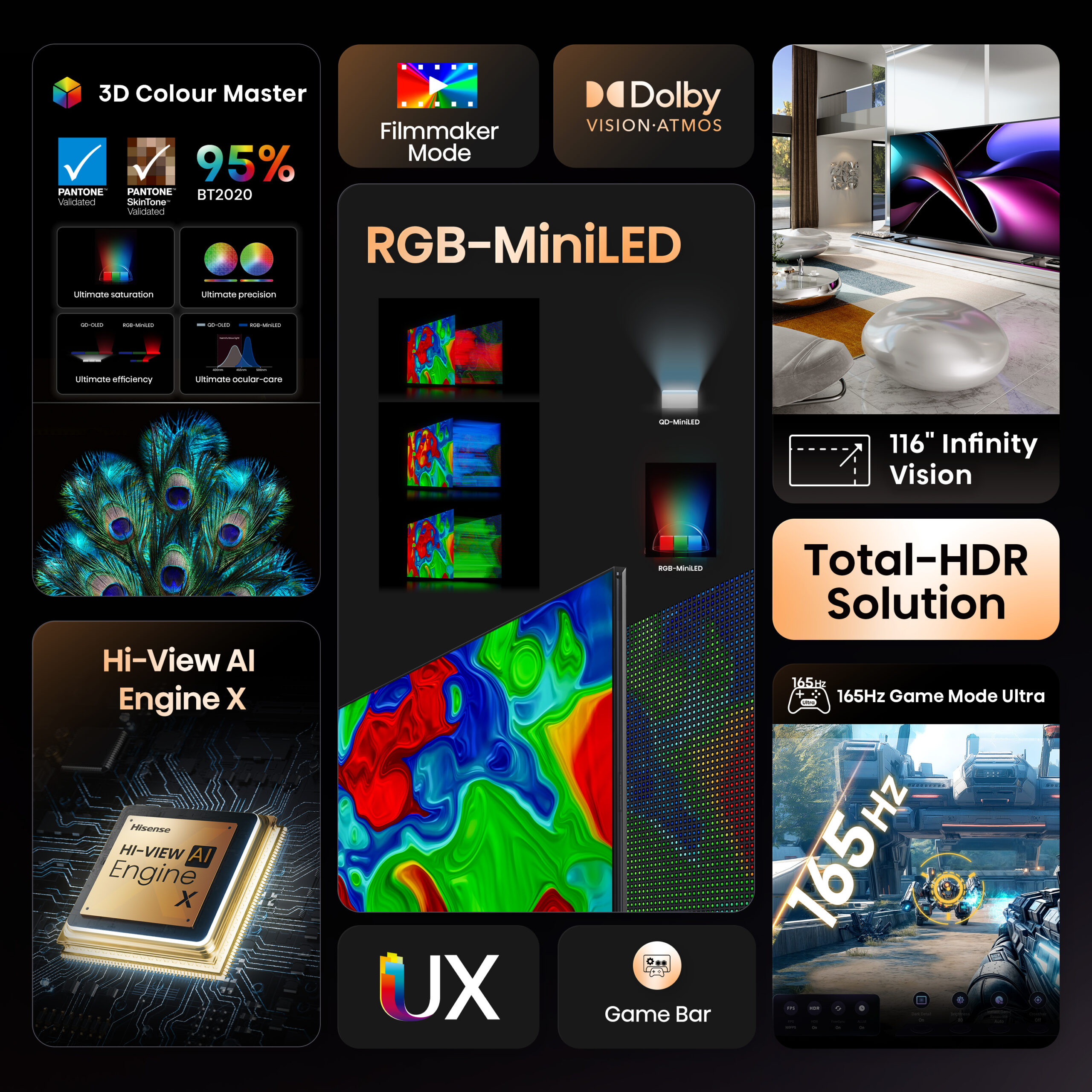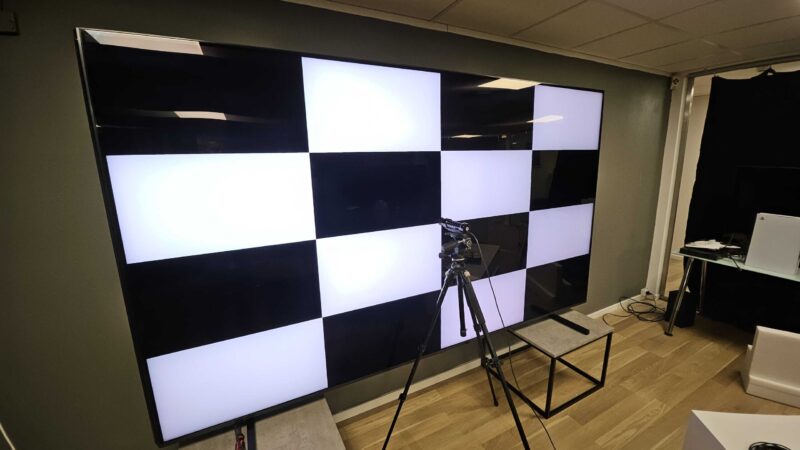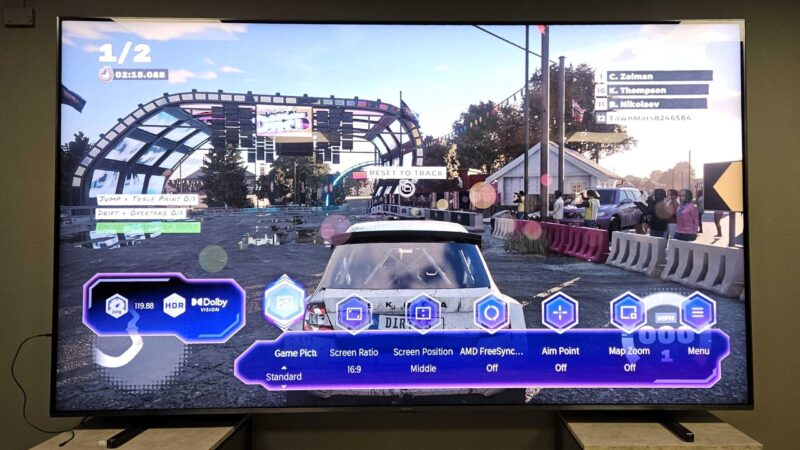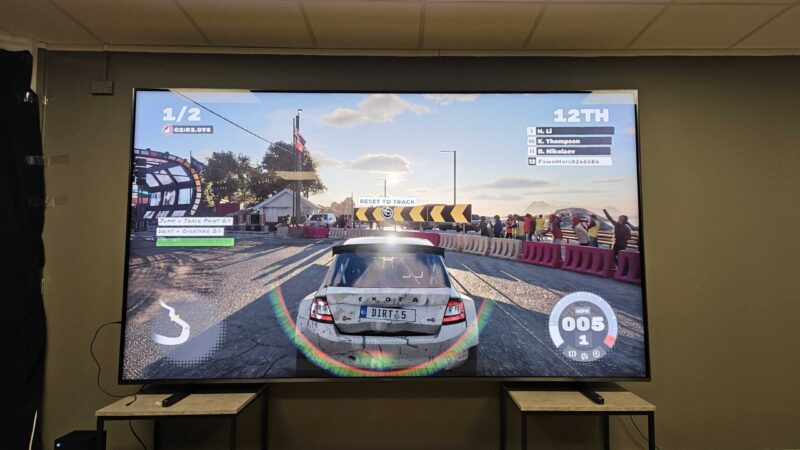Hisense is a TV manufacturer we haven’t heard much about in Denmark, but apparently they want to change that. The Chinese manufacturer is now aiming for wider distribution in the Nordics. At the top of the range is the flagship model Hisense 116UXQ, which Lyd & Billede is among the first to test.
This very exciting TV screen is the first on the market with so-called RGB MiniLED technology and the first to support the updated Dolby Vision 2 HDR format. It’s also by far the biggest TV to ever visit our test room!
Hisense 116UX: ‘The world’s largest LCD TV’ – welcome to the test room!
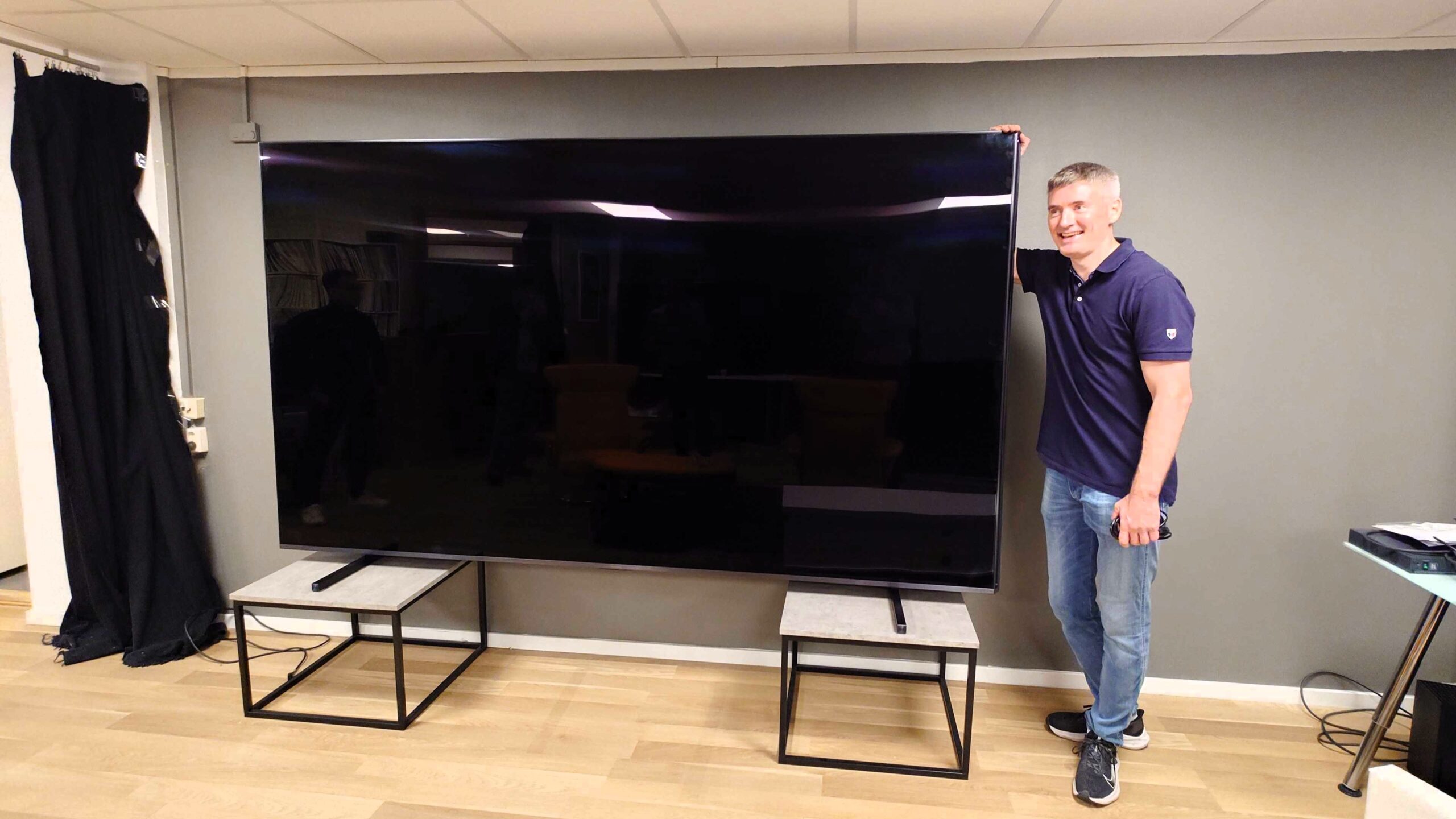
A year and a half ago we tested the gigantic TCL 115X955, and now it’s the turn of the Hisense 116UXQ. These are the TV screens for those who want a huge picture in their living room or home cinema without having to compromise on the lower brightness and blackout that a projector solution typically entails.
You’ll need to have plenty of money to spare though, because this top-of-the-range model doesn’t come cheap. You’ll need to shell out €30,000 to make this TV yours.
However, there are even bigger and more expensive TVs than this: Hisense also has a MicroLED TV in its range – the Hisense 136MX – which combines individual display modules into one large screen of up to 136 inches. MicroLEDs are known for their extreme picture quality, but million-dollar prices make them out of reach for most people and this model is not yet expected in the Nordic countries.
The Hisense 116UXQ, on the other hand, is the largest TV you can actually buy as a finished unit. It attempts to combine some of the best of today’s display technologies in a package that is perhaps more accessible. As a true flagship model, it uses new technology – RGB MiniLED – which will hopefully trickle down to more affordable models in time.
Hisense 116 UX: Design and build quality
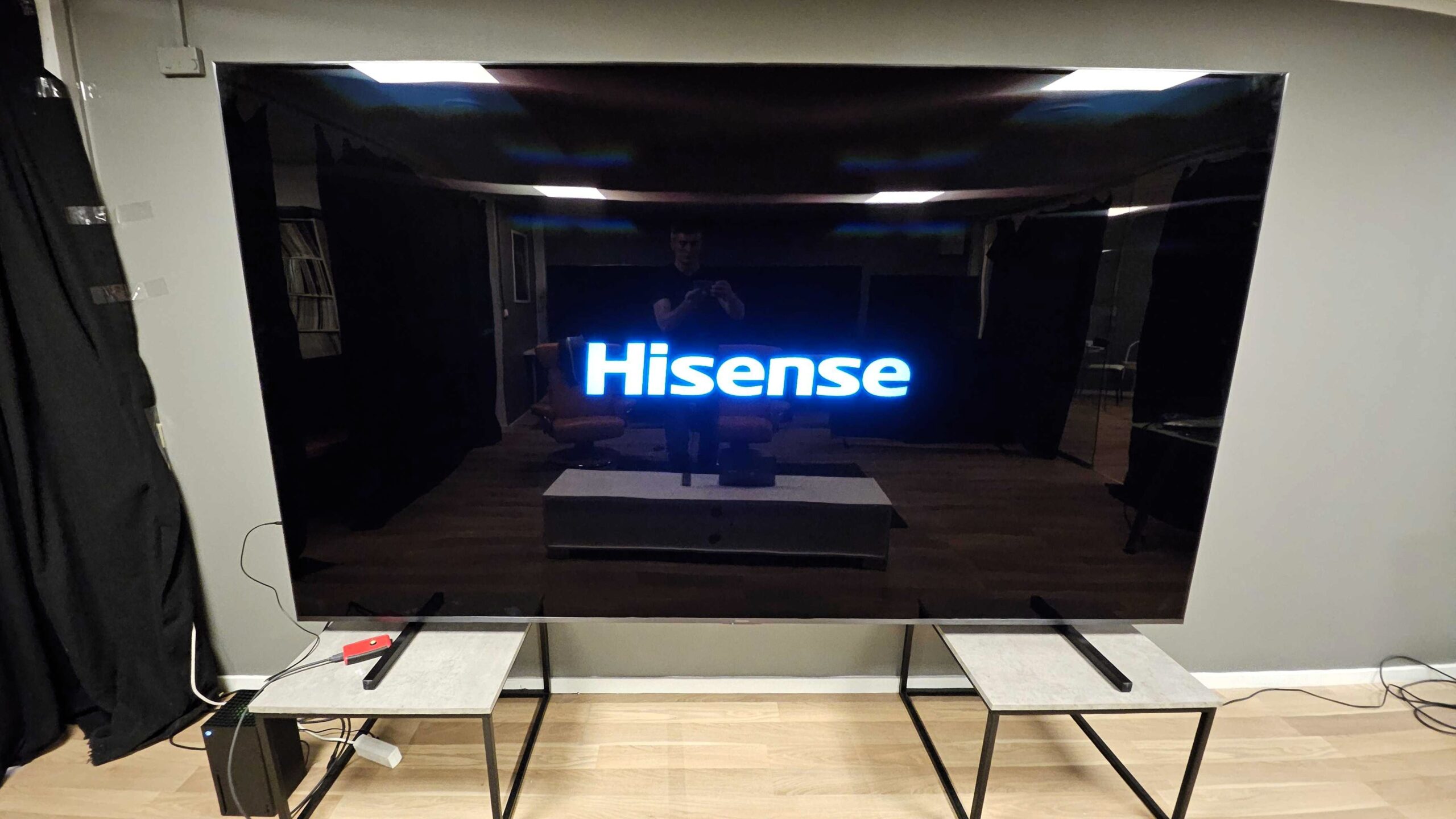
The name promises 116 inches, but the control measurement shows 115.5 – so Hisense has rounded up just a bit! But it’s definitely a massive – and lead heavy – TV screen.
At 2.63 metres wide and 1.48 metres high, the 116UX has a screen area of 3.9 square metres – about as much as four 55-inch TVs combined. Imagine playing Mario Kart with your friends on such a big screen!
A little brother to the Hisense 116UX is also expected, the 100UX to be precise, and it looks to have vital measurements of 102 inches if the specs are right.
Speaking of which, a word of caution when it comes to jumbo-sized TV screens: Giant TV screens like the Hisense 116UX are no joke. The TV alone weighs over 100 kilos, and with packaging we’re talking almost double that. It takes at least 3-4 people to move and unpack it properly. Just getting it in the door is an endeavour!
We would therefore strongly recommend that you order your TV delivered to your door, preferably with professional installation included if possible. It may cost a few hundred euros extra, but it’s a cheap ‘insurance’ against mishaps along the way.
Ease of use and features
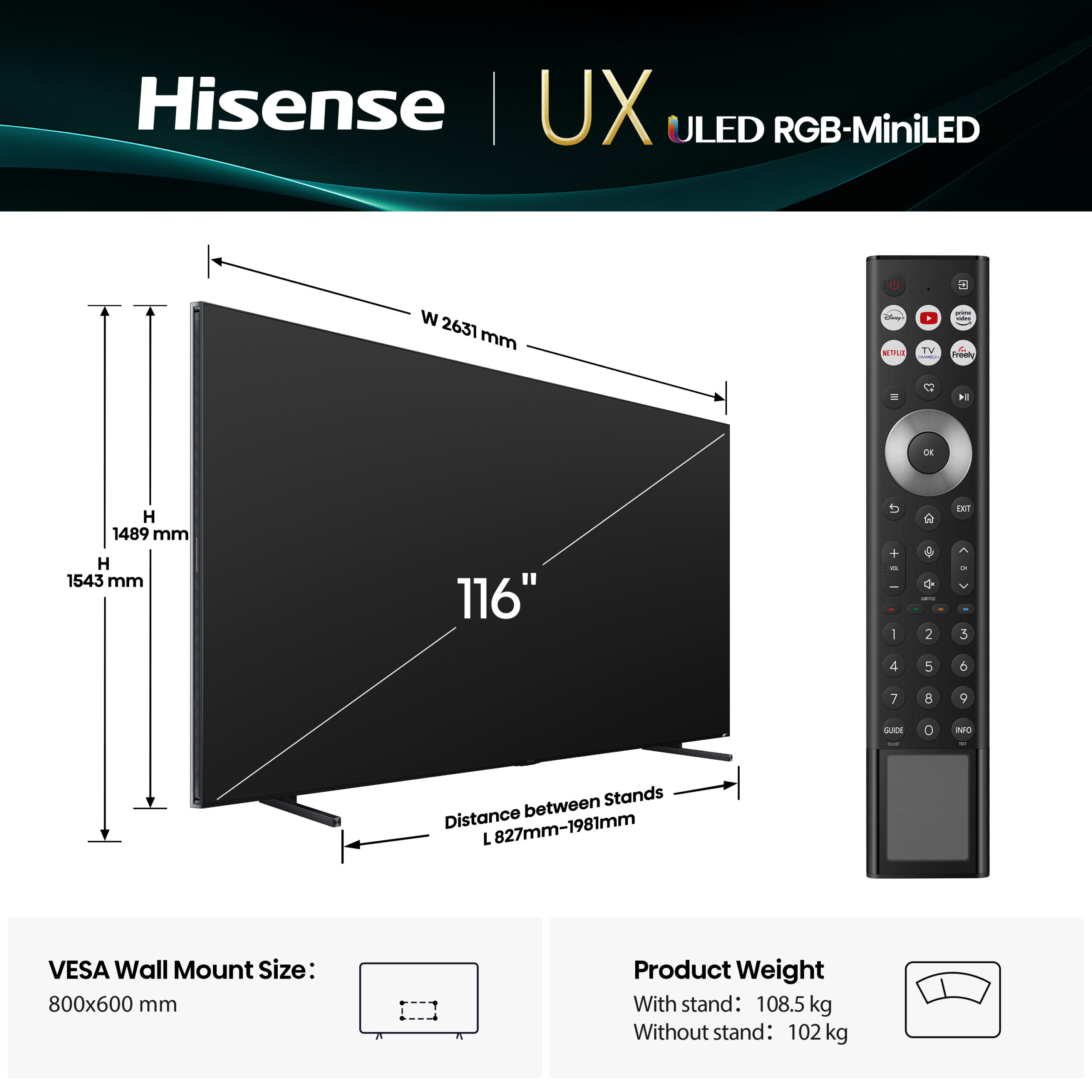
Unlike TCL and many others, the Hisense UXQ is not a Google TV. Instead, it comes with the VIDAA U 9.0 operating system, which is the manufacturer’s own user interface.
The latest version has been given a facelift, making the menus clearer and easier to familiarise yourself with. The most positive aspect is that it’s responsive and loads menus and apps in record time. That’s something you can quickly get used to!
We’ve tested the VIDAA system on several occasions in the past and the speed has always been impressive, but the app selection has been less good. Fortunately, there has been a clear improvement since our last test: Hisense has the main streaming services in place, including the Nordic TV stations NRK, SVT and DR. This means you can get by without a separate streaming box.
When it comes to connectivity, Hisense also stands out from the competition. We actually had to count the number of inputs to be sure, but it turns out that the UXQ makes do with 3 – three – HDMI inputs. This may seem a little odd for a TV that costs over two hundred thousand dollars. In fact, it should have at least half a dozen!
At least Hisense has made sure that all three are 2.1 standard with up to 4K/165Hz. There’s also a USB-C/DisplayPort input on the side of the monitor, which is easily accessible for connecting a PC.
But an additional HDMI input on the side wouldn’t be bad either. The other inputs can be harder to reach, especially if you hang the monitor on the wall.
RGB MiniLED brings new life to LCD
Ten years ago, many predicted that LCD technology would be ‘dead and buried’ and that OLED TV would take over by 2025 – especially in the upper high-end class, where extremely high demands are placed on picture quality. So why do manufacturers continue to invest more in LCD, you might ask?
The answer probably lies in the fact that LCD is still cheaper to mass produce and easier to cut and roll out in large quantities and screen sizes. OLED, despite its excellent image quality, still has a number of challenges in the production phase. LCD is simply a more reliable way to make money, and in an industry with small margins, this is naturally appealing.
The new RGB MiniLED technology is the latest attempt to revitalise LCD displays so they can last a few more years. Samsung, Sony and other manufacturers are planning something similar, but Hisense is first to market with the variant they call ‘TriChroma’.
Okay, Hisense hasn’t reinvented the colour TV, only almost: Specifically, we’re now talking about the backlight behind the LCD screen, which now consists of coloured LEDs. So it’s still a backlit screen and not a ‘luminescent’ screen like OLED or MicroLED.
But – instead of using blue LEDs and phosphor coatings to send white light through the LCD, separate LEDs are now used for each of the primary colours red, green and blue (RGB). This means that light and colours can pass through the panel more efficiently with less light loss as there is no need to filter out white. As a result, great improvements in both brightness and colour saturation can be achieved.
It may sound simple, but it’s actually quite complicated because it requires a lot of high-quality colour LEDs and precise control of the backlight in accordance with the video signal. But as long as the backlight is synchronised and the colours are mixed correctly, it can provide many benefits.
Amazing brightness
After getting the Hisense giant on the TV bench(s), it was time to see what this monitor could deliver in terms of picture quality. First, we took some basic measurements.
The Hisense 116UX squeezed out around 4,800 nits of brightness with 10 per cent of the screen area in white – by far the brightest we’ve measured so far. As expected, the brightness drops somewhat as the screen area increases, but even with the entire screen in white (100% window) it retains a brightness of just over 900 nits, which again is the brightest we’ve measured so far.
Please note that these figures are still far from what the manufacturer itself states in its specifications. Hisense itself states a brightness of around 8,000 nits. This may be due to different test conditions and equipment or a different way of measuring peak brightness.
In comparison, the TCL 115X955 achieved a brightness of around 3,800 nits and 890 nits in the same test scenarios when we tested it last year, which was also somewhat lower than the manufacturer claimed.
The usual white light measurements only tell part of the story, however, as the Hisense 116UX is also almost equally bright in primary and secondary colours. Naturally, the RGB LEDs enable the display to produce amazing brightness across the entire colour spectrum. This is combined with an impressively neutral and even colour balance with low delta deviations.
Excellent local dimming
Naturally, we were particularly curious to know how well the local dimming works. LCD displays with MiniLED backlighting have made great improvements in recent years, but will always lag behind OLED displays that can switch every pixel on and off.
However, Hisense seems to have come a little closer with its RGB technology. Even with challenging test sequences with bright objects on a dark background, there was very little hint of halo or halo effect. If anything, it was mostly because the objects were so bright that it was our eyes that created the outline!
And the screen always maintained a convincing black level – without the blue cast we typically associate with regular MiniLED displays. This may be because the backlight is now colour-based and doesn’t let as much light through in dark areas.
Picture quality
Good measurements are always reassuring, but the big question is what kind of picture experience the 116UX is capable of delivering in practice. The test took place during the World Athletics Championships in Tokyo and we got a taste of what the Hisense display is capable of.
We saw hammer throwers, hurdlers and pole vaulters in action and rarely have we come closer to the “live feeling” of the illuminated stadium. It’s safe to say that this TV works brilliantly for watching sports.
For starters, the Hisense 116UX has a very impressive colour reproduction – perhaps the best we’ve ever seen!
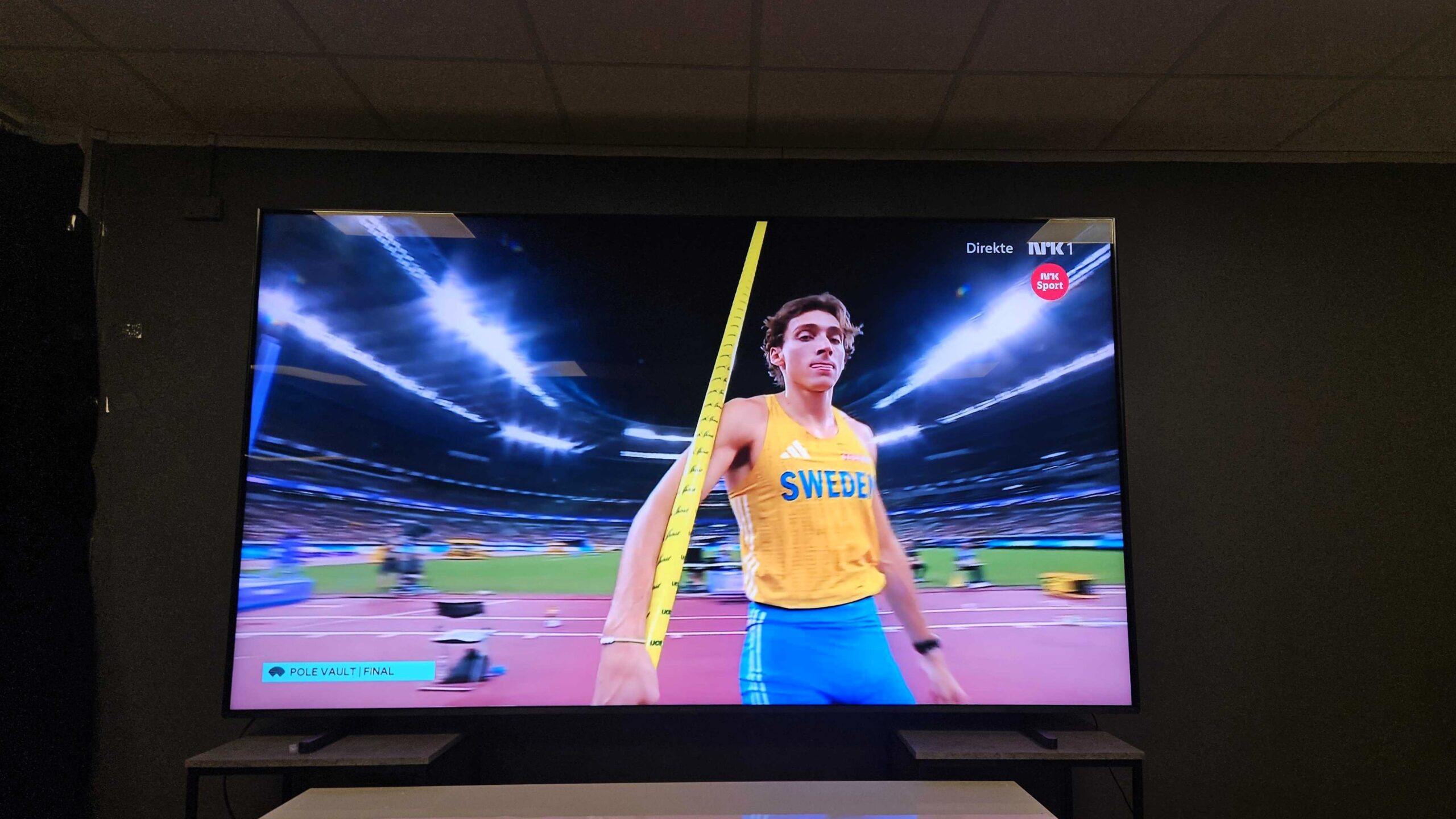
With the sports picture mode, we got a fantastically bright image with a juicy punch and rich hues in the colours. The athletes’ national team outfits shone in all their glory with an impressive range of colours. At the same time, the colours were surprisingly neutral, so skin tones were reproduced in a natural way.
As with the measurements, our first impression was that the Hisense monitor has an impressive colour saturation while still managing to maintain colour balance. This was evident, for example, in Swedish Armand Duplantis’ yellow national team kit and not least in the red colours of the Norwegian and Danish participants.
At the same time, the image was effortless and comfortable to rest our eyes on: we could look at the screen for longer during a sports programme without experiencing eye fatigue. This is perhaps a good example of the benefits of RGB MiniLED.
At the same time, the screen seems to be very little affected by flicker, lag or uneven backlighting. This suggests that the video processor is keeping up with the action, even when the action is fast-paced.
Solid film experience
What about films and series? The big question is how well the Hisense display works for film viewing and gaming of the discerning kind. With the latest movies and shows from Netflix and Disney+, it didn’t take long to realise that the 116UXQ has some pretty remarkable features.
With the F1 series Drive to Survive (one of our favourites), the Hisense screen managed to convey the fast-paced drama of the race track to perfection. The picture was razor sharp and the movement smooth, with contrast and colour reproduction (in Dolby Vision IQ mode) that was frighteningly realistic at times. The only thing missing was the smell of racing petrol, oil and burning rubber.
The Netflix documentary The Universe features many spectacular nature scenes in HDR, but with the Hisense display we literally got to see them in a new light. The cheetah episode from the Serengeti has some sunny scenes that we’ve never seen before with so much punch and colour. Simply a step closer to reality!
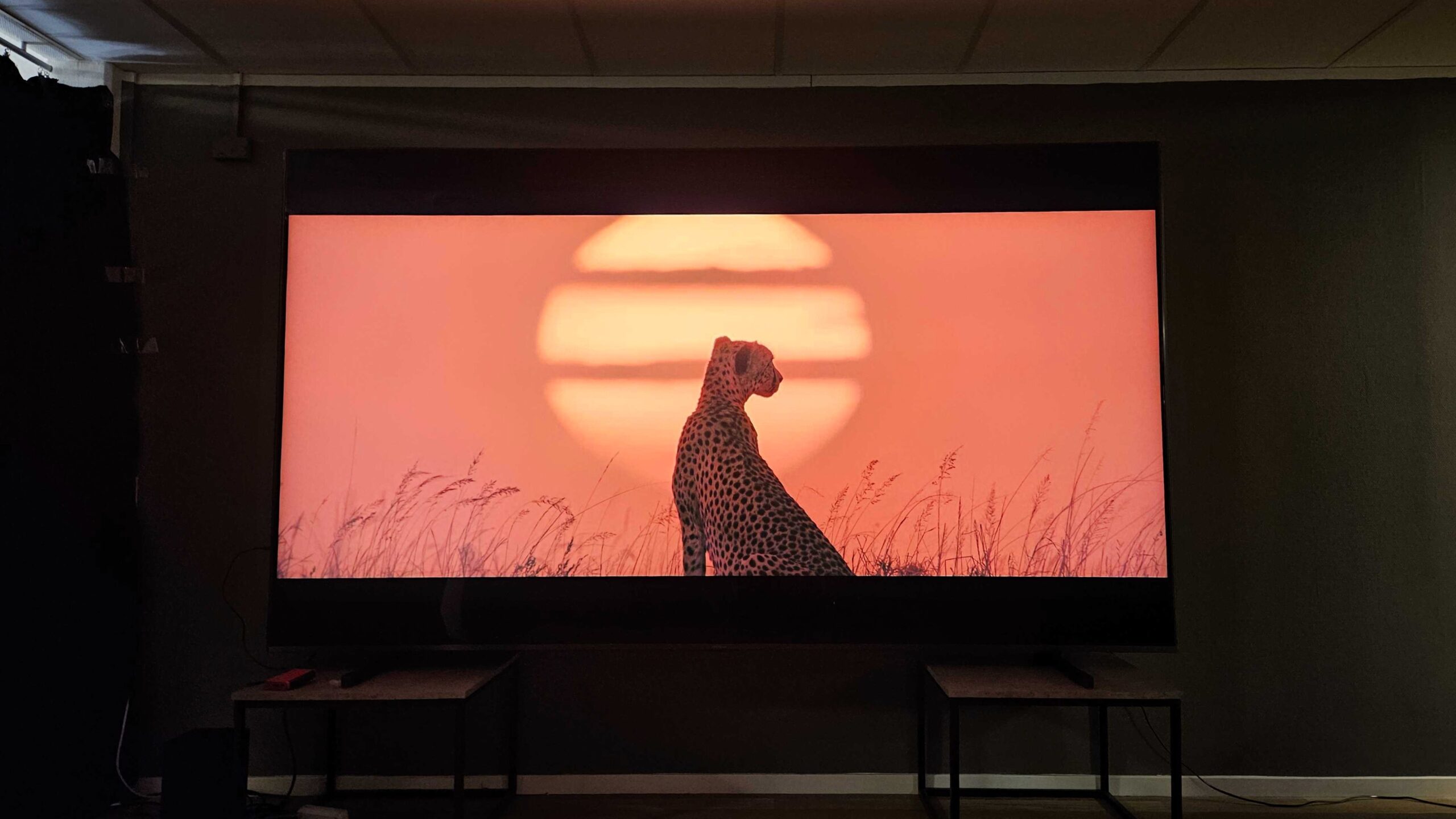
A feature film like Mission Impossible: Fallout is also elegantly served with the film feeling intact. We can see the slightly grainy film quality that is meant to be in the original. And Hisense brings out the detail in dark scenes masterfully.
With a TV of this screen size, it’s clear that the quality of the source material has a lot to say. Older TV shows and films in HD format can easily look a little muddy. Despite effective upscaling and motion smoothing, there are limits to how much it can ‘polish’ old TV footage originally intended for screens a fraction of the size. It’s not necessarily something you can blame Hisense for.
However, there’s no doubt that the Hisense 116UXQ needs 4K signals and preferably HDR to look its best. The magic of RGB backlighting doesn’t really come into its own with regular SDR productions where the lighting is more conservative. They might be worth considering if you’re a film enthusiast who prefers the classics. Until the 4K HDR remaster is released, the old film may seem a little tame!
It’s worth noting that the Hisense UXQ will also be one of the first models compatible with the new Dolby Vision 2 HDR format. Unfortunately, we didn’t have any demo material available in this format yet, but we did get a sneak peek at the IFA fair in Berlin, which seemed promising. The most important takeaway is that the DV2 format is likely to make better use of all the ‘horsepower’ that resides in high-end TVs like the Hisense UXQ.
Some challenges to consider
Hisense has opted for a rather glossy screen glass on this model. It offers its advantages in the black level, but also reflects things like windows and lamps in the room. We’re talking about an almost four square metre black ‘mirror’ in some cases. It’s not visible with bright content such as sports on the screen – then it shines like the sun! But with a dark feature film, it might be a good idea to take precautions. For example, we know that Samsung is planning a matte panel on its upcoming Micro Rgb model.
The viewing angle is also something to consider. As we move to the side, the image gradually becomes more blurred and the colours become paler. But the effect is not as noticeable as on some of the other LCD monitors we’ve seen.
Gaming on the big screen
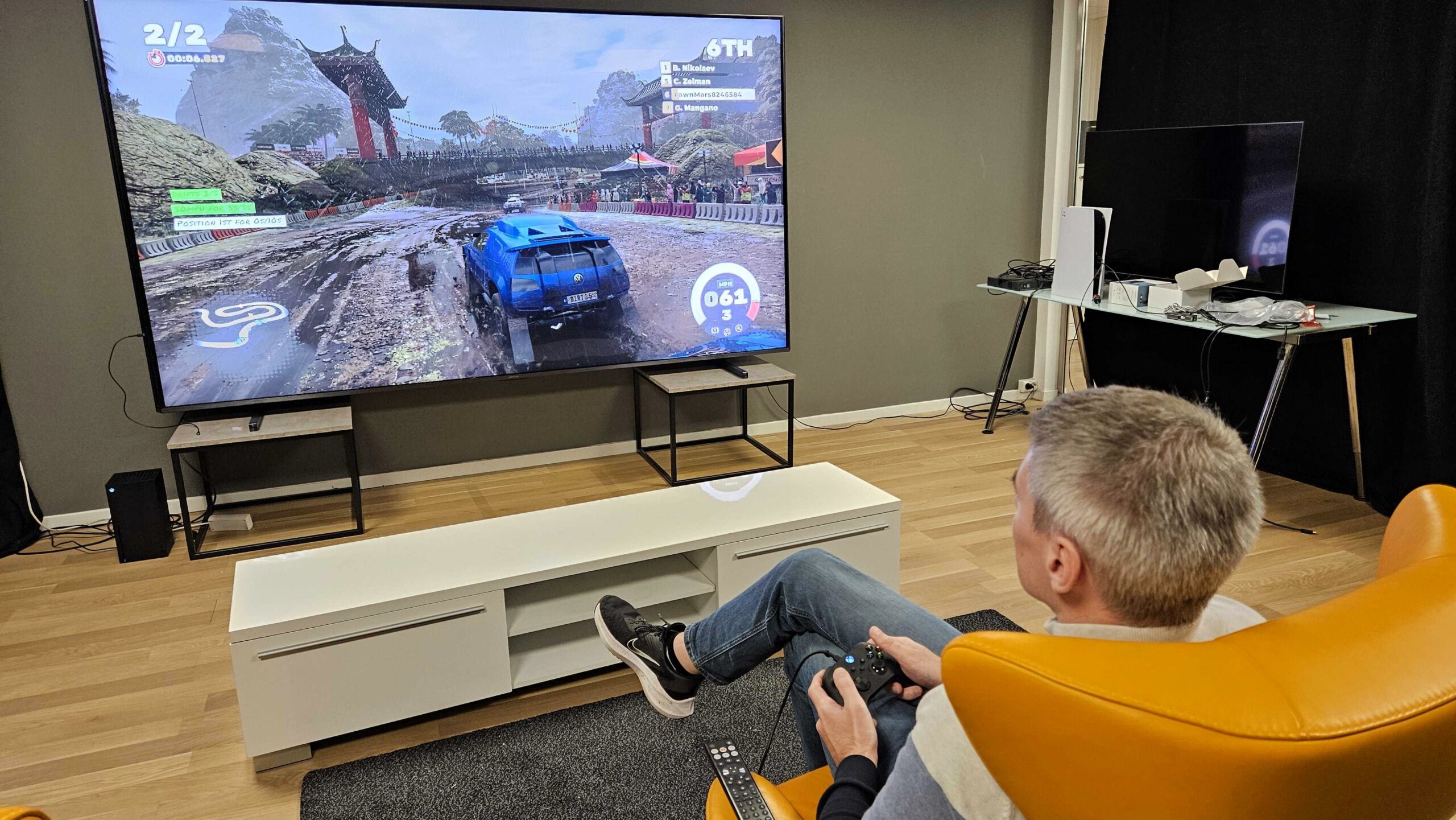
Of course, we couldn’t resist gaming on the Hisense 116UXQ, and it’s really hard to describe the feeling of playing on a 116-inch TV. It just has to be experienced! Here you can lean back in your chair, at a comfortable distance from the screen, and still see EVERYTHING.You can easily see who or what is hiding around the corner or around the next bend. We’re pretty sure this will give you a competitive edge in gaming. The picture quality is pleasant, while the contrast and sense of depth in HDR scenes is quite spectacular.
The Hisense UXQ is well prepared for gaming with three HDMI inputs, all supporting up to 4K/165Hz. It also supports Dolby Vision for gaming and AMD Freesync Premium VRR, which ensures that Xbox titles, for example, can be displayed optimally.
(Exactly why Hisense dropped the fourth HDMI input, we’re not sure, but we assume it’s due to limitations of the chipset used and that three full-bandwidth inputs was the best compromise).
Hisense has also managed to reduce the input lag to an acceptable, if not record low, level. In the supposedly fastest gaming mode (First Person Shooter mode), we measured around 16 milliseconds at 1080p/60 Hz.
The fastest gaming monitors typically manage less than 10 milliseconds in the same mode. The reason the UXQ needs a little more time may be that controlling the RGB MiniLED panel requires a few extra milliseconds to create an optimal image.
Sound quality
As befits a large screen in this class, the Hisense 116UXQ is equipped with a comprehensive sound system. We’re talking about a 6.2.2 setup with speakers placed above, below and on the sides of the screen, complemented by two dedicated woofers on the back. Hisense also enlisted the help of French Devialet to fine-tune the different sound modes.
The result is a sound reproduction that is both clear and rich, with clear voice placement in the centre of the picture. The soundstage feels wide and enveloping, and it feels like the sound is coming from the entire screen rather than a narrow point below it.
However, there’s no doubt that the 116UXQ can’t do without a good soundbar or, ideally, a fully-fledged surround system. And most buyers in this price range will probably have such a setup in place anyway. However, as a temporary solution, it’s more than adequate so you can enjoy both films and sports with solid sound quality right from the start.
Conclusion
With its flagship model, the 116UXQ, Hisense shows that there’s still plenty of power in the old and faithful LCD technology – just give it some ‘RGB therapy’ and increase the screen size to XXXL!
The Hisense 116UXQ isn’t just a flagship TV for those with space and budget – it’s also a demonstration that LCD can still be developed and a glimpse of what TVs of the future could look like.
Using RGB MiniLED technology, the Hisense display manages to deliver both extreme brightness and rich colour saturation, with contrast and black levels closer to OLED than we’ve seen before.
With its colossal screen size, it manages to bring the cinema experience to the living room – almost regardless of the ‘weather’ or lighting conditions in the room. It’s a very potent combination that creates great realism and presence.
The price is steep and the screen is impractically large and heavy. Gaming performance is also solid, but not top notch. Still, RGB MiniLED has the potential to be a real challenger to both OLED and MicroLED, especially as the technology makes its way down into more accessible screen sizes and price ranges.
We expect to see more RGB MiniLED-based LCDs from other TV manufacturers next year – but for now, Hisense has raised the bar!

We think
The Hisense 116UXQ delivers extreme brightness, spectacular colours and impressive black levels thanks to RGB MiniLED technology. It's big and heavy, expensive and difficult to position. Gaming performance is good, but not on par with the very fastest monitors.
29999 €
Specifications
- Size/type: 116″ 4K LCD (RGB MiniLED)
- Resolution: 3840 × 2160 (4K Ultra HD)
- Panel frequency: 48-165 Hz
- Operating system: VIDAA U7
- Inputs: 3 HDMI 2.1, 2 USB
- Outputs: Optical digital audio output, HDMI eARC
- HDR: Dolby Vision 2, HDR10+ Adaptive, HLG
- Sound system: 6.2.2 channels with Devialet tuning
- Other: TriChroma RGB MiniLED backlighting
- Web: hisense.com


